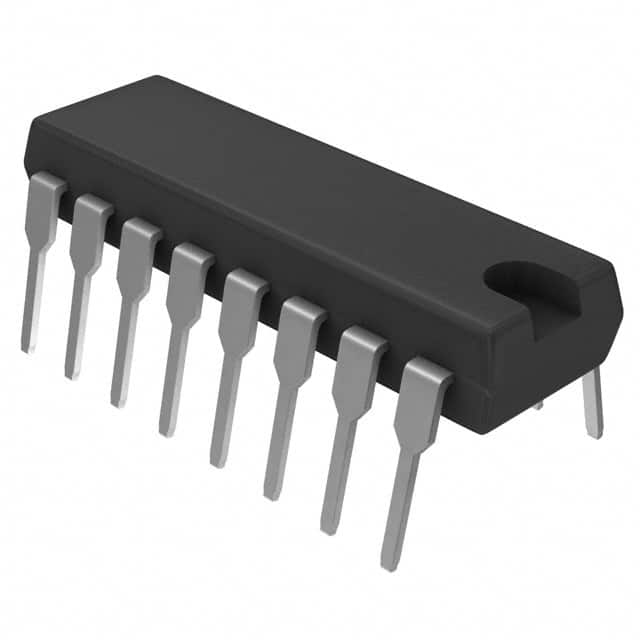Lihat spesifikasi untuk detail produk.

CD74HC251E
Product Overview
- Category: Integrated Circuit (IC)
- Use: Data Selector/Multiplexer
- Characteristics: High-Speed CMOS Logic, 8-Channel Multiplexer
- Package: DIP (Dual In-line Package)
- Essence: CD74HC251E is a multiplexer IC that allows the selection of one out of eight data inputs and routes it to a single output.
- Packaging/Quantity: Available in tubes or reels, with varying quantities depending on the supplier.
Specifications
- Supply Voltage: 2V to 6V
- Logic Family: HC (High-Speed CMOS)
- Number of Inputs: 8
- Number of Outputs: 1
- Operating Temperature Range: -40°C to +85°C
- Propagation Delay: 14 ns (typical)
- Output Current: ±25 mA
- Input Capacitance: 3.5 pF (typical)
Pin Configuration
The CD74HC251E has a total of 16 pins arranged as follows:
+-----+
A0 -|1 16|- VCC
A1 -|2 15|- Y
A2 -|3 14|- GND
A3 -|4 13|- S0
A4 -|5 12|- S1
A5 -|6 11|- S2
A6 -|7 10|- S3
A7 -|8 9|- E
+-----+
Functional Features
- CD74HC251E is designed to provide high-speed data selection and routing capabilities.
- It offers a wide supply voltage range, making it suitable for various applications.
- The multiplexer has a low power consumption, making it energy-efficient.
- It provides a single output that can be selected from eight different data inputs.
- The IC has a compact DIP package, allowing for easy integration into electronic circuits.
Advantages and Disadvantages
Advantages: - High-speed operation enables efficient data selection. - Wide supply voltage range enhances versatility. - Low power consumption contributes to energy efficiency. - Compact package facilitates integration into circuits.
Disadvantages: - Limited number of outputs may restrict certain applications. - Propagation delay may affect real-time data processing in some cases.
Working Principles
CD74HC251E operates based on the principles of digital multiplexing. It uses control signals (S0-S3) to select one of the eight data inputs (A0-A7) and routes it to the output pin (Y). The enable signal (E) determines whether the multiplexer is active or in a high-impedance state.
Detailed Application Field Plans
CD74HC251E finds applications in various fields, including:
- Digital Communication Systems: Used for data routing and selection in communication protocols.
- Industrial Automation: Enables efficient data selection in control systems.
- Instrumentation: Utilized for signal routing and selection in measurement devices.
- Consumer Electronics: Integrated into audio/video equipment for input/output selection.
- Automotive Electronics: Employed in vehicle control systems for data routing.
Alternative Models
Several alternative models with similar functionality are available in the market. Some notable alternatives to CD74HC251E include:
- SN74HC251N by Texas Instruments
- MC74HC251N by ON Semiconductor
- 74HC251 by NXP Semiconductors
These alternatives offer comparable features and can be considered as replacements for CD74HC251E based on specific requirements.
In conclusion, CD74HC251E is a high-speed CMOS logic IC that serves as an 8-channel multiplexer. It offers efficient data selection and routing capabilities, making it suitable for various applications in digital communication systems, industrial automation, instrumentation, consumer electronics, and automotive electronics. While it has advantages such as high-speed operation and low power consumption, its limitations include a limited number of outputs and propagation delay. Alternative models from different manufacturers provide similar functionality and can be considered as substitutes.
Sebutkan 10 pertanyaan dan jawaban umum terkait penerapan CD74HC251E dalam solusi teknis
Sure! Here are 10 common questions and answers related to the application of CD74HC251E in technical solutions:
Q: What is CD74HC251E? A: CD74HC251E is a multiplexer/demultiplexer integrated circuit (IC) that allows for the selection of one of eight data inputs and routing it to a single output.
Q: What is the operating voltage range of CD74HC251E? A: CD74HC251E operates within a voltage range of 2V to 6V.
Q: How many data inputs does CD74HC251E have? A: CD74HC251E has eight data inputs, labeled D0 to D7.
Q: Can CD74HC251E be used as a demultiplexer? A: Yes, CD74HC251E can be used as both a multiplexer and a demultiplexer.
Q: What is the output configuration of CD74HC251E? A: CD74HC251E has a single output, labeled Y.
Q: What is the maximum frequency at which CD74HC251E can operate? A: CD74HC251E can operate at a maximum frequency of 50 MHz.
Q: Does CD74HC251E have any built-in protection features? A: No, CD74HC251E does not have built-in protection features. External measures may be required to protect against electrostatic discharge (ESD) and other potential hazards.
Q: Can CD74HC251E be cascaded to increase the number of inputs? A: Yes, multiple CD74HC251E ICs can be cascaded together to increase the number of inputs and outputs.
Q: What is the power supply current consumption of CD74HC251E? A: The power supply current consumption of CD74HC251E is typically around 4 mA.
Q: What are some common applications of CD74HC251E? A: CD74HC251E is commonly used in digital systems for data routing, address decoding, and multiplexing/demultiplexing tasks. It can be found in various electronic devices such as computers, communication systems, and industrial control systems.
Please note that these answers are general and may vary depending on specific datasheets and application requirements.

